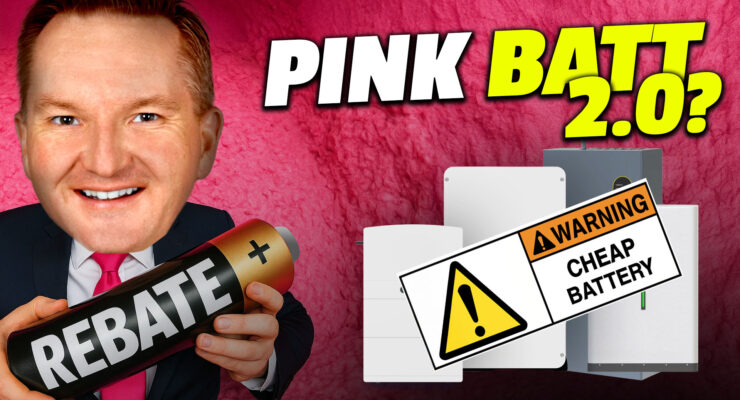
Powering Your Home: Navigating Australia’s Federal Battery Rebate
Australia is on the cusp of a major shift in home energy, with the Federal Battery Rebate launching on July 1, 2025. This $2.3 billion initiative aims to make home battery storage more accessible, reducing electricity bills and bolstering the national grid. While the excitement is palpable, industry experts are urging caution, drawing parallels to the ill-fated “Pink Batts” insulation scheme and highlighting the importance of quality products and installation.
What is the Federal Battery Rebate?
The Cheaper Home Batteries Program offers eligible households and small businesses a significant discount (around 30% of the upfront cost) on installing small-scale solar batteries. This discount is provided through Small-scale Technology Certificates (STCs), similar to the existing solar panel rebate, and is based on the battery’s usable capacity, capped at 50 kWh. The value of the rebate will gradually decrease until 2030, meaning earlier adopters will receive a higher subsidy.
To qualify, batteries must:
- Have a nominal capacity between 5 kWh and 100 kWh.
- Be installed on or after July 1, 2025 (though some installed earlier may be eligible if commissioned after this date).
- Be installed with a new or existing solar PV system.
- Comply with Australian standards (AS/NZS 5139:2019 and the Best Practice Guide: Battery Storage Equipment).
- Be listed on the Clean Energy Council-approved product list.
- Be Virtual Power Plant (VPP) capable if installed on-grid.
- Be installed by accredited professionals.
The Pink Batts Precedent: A Cautionary Tale
The enthusiasm for the battery rebate is tempered by memories of the 2009 “Pink Batts” Home Insulation Program. While well-intentioned as a stimulus package, its rapid rollout led to significant safety issues, including the tragic deaths of four young installers due to electrocution and hyperthermia, and reports of house fires and property damage. Critics point to inadequate training, insufficient regulation, and a focus on speed over safety as key failings.
Industry leaders are keenly aware of this history. As Huon Hoogesteger, a veteran of the solar industry, notes, “With every boom, which is what this is, comes a bust. We have gone from caring a lot as an industry caring a lot about the technology to selling boxes. We don’t know what’s in the box.”
Risks and Rewards of the Battery Rebate
The Upsides:
- Accelerated Adoption: The rebate will significantly boost the uptake of home batteries, empowering more Australians to store their solar energy and reduce reliance on the grid.
- Grid Stability: Increased battery storage helps balance electricity supply and demand, contributing to a more stable and resilient national grid.
- Reduced Bills: For homeowners, a battery allows them to use their self-generated solar power during peak evening hours, substantially cutting electricity costs.
The Risks:
- Quality Control: A surge in demand could lead to an influx of low-quality or untested products, particularly from new, less reputable manufacturers. Stuart Joyce warns against “new co battery company cheap out of China… people who are not buying high-quality brand names are really taking the risk.”
- Installer Competence: The rapid expansion may attract inexperienced installers, potentially leading to unsafe or substandard installations. Concerns exist about whether there will be enough adequately trained professionals to meet demand.
- Cash Flow Issues for Small Businesses: Neil Yang highlights potential “cash flow issues” for smaller installers due to the upfront cost of expensive batteries and the time it takes to process rebates.
- Rebate Exhaustion: Thomas Bywater suggests the $2.3 billion might be depleted faster than the projected five years due to overwhelming demand, potentially leaving some consumers disappointed.
- “Race to the Bottom” on Price: The temptation to offer the cheapest quotes could compromise quality, leading to long-term problems for consumers. As one expert puts it, “The poor man pays twice. Probably the poor man pays 10 times in the case of batteries. So, just don’t do cheap.”
Protecting Yourself: What Consumers Need to Know
To avoid a “Pink Batts 2.0” scenario and ensure a positive battery experience, experts advise consumers to be discerning:
- Prioritise Quality Brands: Choose batteries from established manufacturers with a proven track record and strong local support. Companies like LG Chem, despite past recalls, demonstrated their commitment by investing millions in rectifying issues.
- Vet Your Installer: Ask about their experience with battery installations, what training they’ve undertaken beyond the basics, and ensure they are accredited. Look for installers who are part of schemes like the New Energy Tech Consumer Code (NETCC) or accredited by Solar Accreditation Australia.
- Understand Your Warranty: Be aware that under Australian Consumer Law, distributors can be liable if the original installer or manufacturer disappears. Reputable distributors like Solar Juice focus on quality brands to mitigate this risk for themselves and consumers. Ensure your battery comes with a solid warranty and that the company providing it is likely to be around for the long haul (6, 8, or 10 years).
- Don’t Just Go for the Cheapest Quote: A significantly lower price might indicate compromises on product quality or installation standards. As experts warn, “Don’t go for the cheap stuff.”
The Path Forward: Quality, Training, and Consumer Awareness
The federal battery rebate presents an unprecedented opportunity for Australia to become a world leader in solar-plus-battery integration. However, its success hinges on a commitment to quality products, rigorous installer training, and an informed consumer base. The government and industry stakeholders are actively working to prevent a repeat of past mistakes, with promises of high inspection rates and a focus on serious implementation.
The “solar and battery coaster,” as one expert terms it, is set to take off. By choosing wisely, consumers can ensure their journey is a smooth and rewarding one, rather than a nightmare.

